|
|
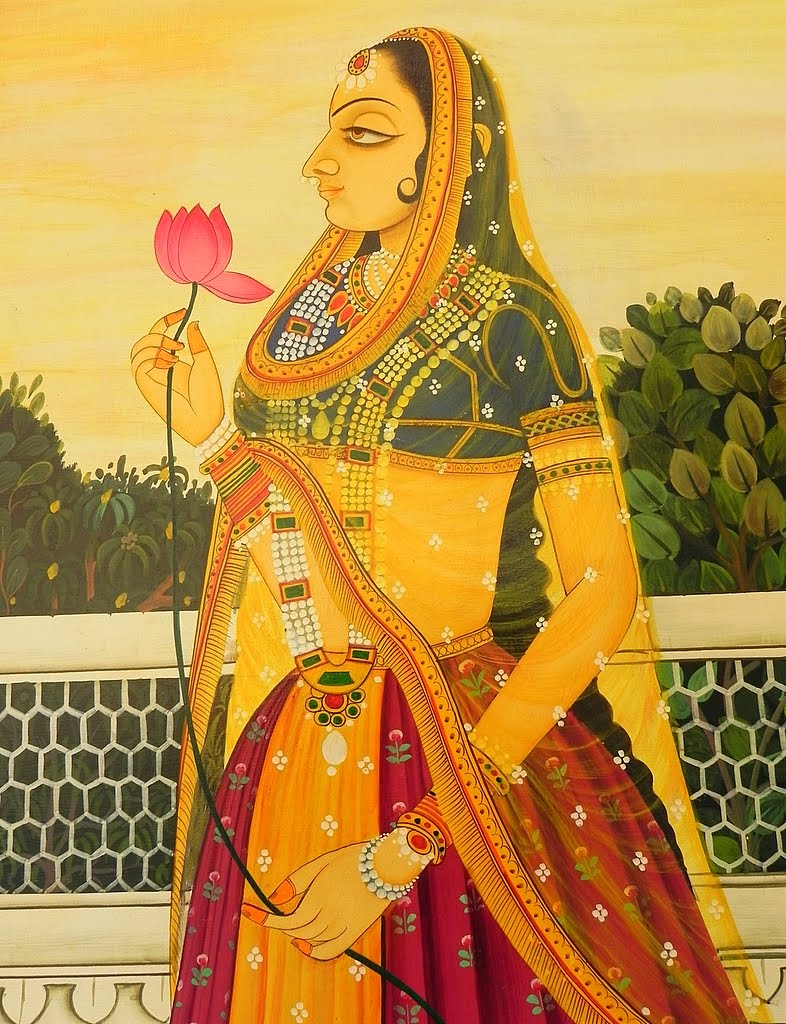 |
|
Paintings |
|
Introduction
of
Paintings |
|
Rajputana-
Art Treasure of India: - Rajasthan is the land of wonderful legends of
romance and bravery. India's region in the north-west corner of the
sub-continent is of amazing beauty- packed with art, history, and
culture that goes back to several centuries.
Rajasthanís role in the expansion of Indian art has been very
significant. One of the most innovative and significant example of
Rajasthani art treasures is the world of miniature painting. As early
as the beginning of the 16th century artists of Rajputana, as
Rajasthan was called in ancient times, were practicing and perfecting
this art. The spirit of Rajasthan's history and legend, coloured by
Courage and romance, finds expression in miniature paintings of
different painting schools. Pure Rajput paintings and those affected by
Mughal court give an interesting awarness into the lifestyle of the
centuries and continue to attract scholars to this day.
Rajasthan Paintings:Rajasthan Paintings were founded at Udaipur in
1996.Rajasthan Paintings are placed in Udaipur - The City of Lakes.
When you come to Rajasthan Paintings you can be sure that you have
come to the right place where you satisfy your search for Rajasthani
Art. Our group of more than 12 experienced artists are expert in
reproductions of all kind of themes on different material. Today
Rajasthan Paintings have developed as one of the important art schools
of Rajasthan. Thatís the main reason why art lovers from all over the
world who are fond of Rajasthani Miniatures paintings visit Rajasthan
Paintings. Here one can see a wide range of high-quality paintings
from well-known Rajasthan.
The traditional Indian painting started failing after the first half
of the 18th century and by the end of the century it lost most of its
strength and attraction. However, in the Pahari region the art of
painting uphold its quality till the end of the first quarter of the
19th century. The traditional styles of Indian painting finally died
out in the second half of the 19th century under the conflict of the
Western colours and method of painting.
|
|
Miniature Painting |
|
As
Hindu-rulers of Rajputana carry on close political and social links to
the Mughal court, one can examine strong Mughal influence paintings
here.Influenced by the surroundings, miniature paintings have their
own unique style; court assemblies and hunting expeditions, hills and
valleys, religious festivals, processions and scenes from the life of
Lord Krishna - a widely devoted Hindu God in India.
Miniature paintings are different in size and material. Paper, silk
and wood was used, for more precious paintings also marble and ivory.
The colours were made from minerals and vegetables, valuable stones as
well as pure silver and gold. The mixing and preparing of colour was
an elaborate process. It took weeks, sometimes months, to get the
desired results. The brushes have to be very fine and are therefore
prepared by the artists themselves. To get high-quality results, the
brush is even today made from hairs of the squirrels, tail- carefully
cut without harming the little animal.
|
|
Tradition of Miniature Paintings in Rajasthan |
|
The
tradition of the miniature paintings in Rajasthan is very rich in its
form, colors, texture, and storytelling. The Kishangarh School of
miniature Rajasthani Painting is one of the popular and richest forms.
Rajasthan is the main center of this art and even today regions of
Jodhpur, Jaipur, Udaipur and Kota look after the art schools of
miniature paintings. The two chief school of the art are the Mughal
School and Rajput School. While Mughal school is obvious by moderate
colors to give depth, the Rajput have skills in using colourful
exciting shades to make it more showy.
|
|
Amalgamation of art, poetry and classical music in medieval India.
|
|
The origin
of miniature paintings is embedded in the history of Rajasthan. A land
known for its artistry Rajasthan has always been famous for these
little wonders. The numerous invasions in Rajasthan have left an
unforgettable mark on its history and culture.The miniature paintings
reflect this too.
Various types of Rajasthani schools of Paintings are prospered in
Rajasthan from the 16th century onwards. Some of the Famous School Of
Paintings are -The Mewar school, Bundi school, Kota School, Bikaner
School, Jaipur School, Marwar School and Kishangarh School. Each
Rajasthani school of Painting has its distinct and unique style.
Rajasthani school of Painting remained entirely traditional in its
supernatural example of Indian Literature and the Indian epics.
Therefore we will definitely say that the expansion of the Rajasthani
school of Paintings is the pictorial match of the native literature of
India. In this regard Rajasthani School of Paintings may be presented
as a mixture of folk art with classic and hieratic traditions.
It is really interesting that in Rajasthan the art of wall painting
received a new lease of life with the paintings of Palaces and Havelis
which was then in trend in the early 18th century. Among the
Rajasthani school of Painting the school of Kota, Bundi and Bikaner
adapted some of the typical conventions of the Mughal miniature. The
much followed depictions of these wall paintings are battles and the
parade and folk deities. Folk style art was main in portraying the
art. The wall paintings in the Palaces of Bikaner, Udaipur and Bundi
are still considered as the classical works of art and artistry of
Rajasthani school of Painting which carefully advanced the art and
artistry of India.
A number of Hindu Rajput Kingdoms like Bikaner, Jodhpur, Bundi, Kota
and Mewar support Indian art in Rajasthan. Many were extremely
affected by the Mughal style of Painting while some diverge from the
typical style of Mughal miniature.Rajasthani school of painting with
its absolute splendor demonstrates a particular school of art which
once stood apart in terms of both subject matter and formation from
exactly the modern work of the artists attached to the courts of the
Mughals.
|
|
Various Schools of Miniature Paintings |
|
Jodhpur
School of Miniature Paintings - The Jodhpur school of miniature
paintings is the heart of Rajasthan. relay. The tourists will be
surprised to see the elaborative art work.These paintings are prepared
by hand and show love scenes of famous lovers like Dholu and maru on
camel back. Hunting scenes with animals like elephants and horses are
also seen here which become the most popular figures. A lot of gold
and stone colors are used to paint them.
Mughal School of Miniature Paintings - Once upon a time the kingdoms
of Amer, jaipur, Bairat and many others have good relations with the
Mughals.The latter, too, were well-known for its crafts. Hence the
outcome of these two influences Popularized love scenes and the Mughal
royal courts as their main themes. These were painted on silk by using
golden and stone colors. Bikaner too was known for the Mughal influence
on its art. Here the used colors are prepared from precious stones,
vegetables, silver, minerals, indigo, and pure gold.
Bani Thani Paintings - Bani Thani Paintings are another Popular
school of miniature paintings.Fabulous features are to be seen in this
totally different type of painting. This form of painting has derived
its name from the singer poet of Nagari Dasís (Raja Sawant
singh) court, Bani Thani. Miniature Paintings is still done in the
regions of Jaipur, Kishangarh and others.
Mewar Paintings - The initial example of Mewar painting is a series
of the Ragamala painted in 1605 A.D. at Chawand, a small place near
Udaipur, by Misardi. Most of the paintings of this series are in the
set of Shri Gopi Krishna Kanoria. One more vital series of the
Ragamala was painted by Sahibdin in 1628 A.D. Other examples of the
Mewar painting are the illustration to the third book (Aranya Kanda)
of the Ramayana dated 1651 A.D., in the Saraswati Bhandar, Udaipur,
the seventh book (Uttara Kanda) of the Ramayana dated 1653 A.D. in the
British Museum, London and a series of the Ragamala miniature of
almost the same period in the National Museum, New Delhi. An example
from the Ragamala series painted by Sahibdin in 1628 A.D. which is now
in the National Museum, is the miniature that shows the Lalita
Ragini.The heroine is lying on a bed with her eyes closed under a
painted pavilion with a door, while a maid presses her feet. Outside,
the hero is seen carrying a thread of material in both hands. In the
foreground is a caparisoned horse with a groom sitting near the steps
of the pavilion. The drawing is bold and the colours are colorful and
different. The text of the painting is written in black on the top
against the yellow ground.
Bundi Paintings - The Bundi style of painting is very close to the
Mewar style, but the former excels the latter in quality. Painting in
Bundi started as early as around 1625 A.D. A painting showing Bhairavi
Ragini, in the Allahabad Museum is one of the earliest examples of
Bundi painting. Some examples are illustrated books of the Bhagatwata.
Purana in the Kotah Museum and a series of the Rasikapriya in the
National Museum, New Delhi. )"The Bundi School" is an important school
of the Rajasthani style of Indian miniature painting that lasted from
the 17th century till the end of the 19th century. In this generous
state. Ragamala series of paintings (1561), represent various Indian
musical Ragas.
Bikaner Paintings - Bikaner was one of the States which has close
relations with the Mughals. Some of the Mughal artists during the
later half of the 17th century were given support by the Bikaner court
and were accountable for the introduction of a new style of painting
having much similarity with the Mughal and the Deccani styles. One
important artist Ali Raza "the Ustad (master) of Delhi", was employed
by Raja Karan Singh of Bikaner in about 1650 A.D. Some other
noteworthy artists who worked at the Bikaner court were Ruknuddin and
his son Shahadin.
Amber- Paintings of Jaipur - The State of Amber has very close
relations with the Mughal Emperors. It is usually believed that a
school of painting initiated at Amber, the old capital of the Amber
State, in early 17th century. Later on in the 18th century, the centre
of artistic activity shifted to Jaipur, the new capital. There is a
fairly large number of paintings of the Jaipur rulers and miniatures
on other subjects which can definitely be assigned to the Jaipur
School.
Marwar Paintings - One of the initial examples of painting in Marwar
is a series of the Ragamala in the collection of Kumar Sangram Singh,
painted by an artist named Virji in 1623 A.D. at Pali in Marwar. The
miniatures are implemented in a prehistoric and vital folk style and
are completely uninfluenced by the Mughal style. A large number of
miniatures comprising court scenes, portraits, series of the Ragamala
and the Baramasa, etc. were performed from the 17th to 19th centuries
at several centres of painting like Pali, Jodhpur and Nagaur etc. in
Marwar.
Kishangarh School of Paintings - A beautiful miniature of the
Kishangarh School, from the National Museum collection is shown here.
It depicts a lovely peaceful scene of the return of Krishna with gopis
and cows to Gokula in the evening. The painting is marked by delicate
drawing, fine modeling of the human figures and cows and the broad
view of landscape showing a stream, rows of overlapping trees, and
architecture. The artist has exhibit a masterly talent in the grouping
of many figures in the miniature. The painting has a golden inner
border. It was attributed to the middle of the 18th century and may be
the work of Nihal Chand the well-known artist of Kishangarh.
|
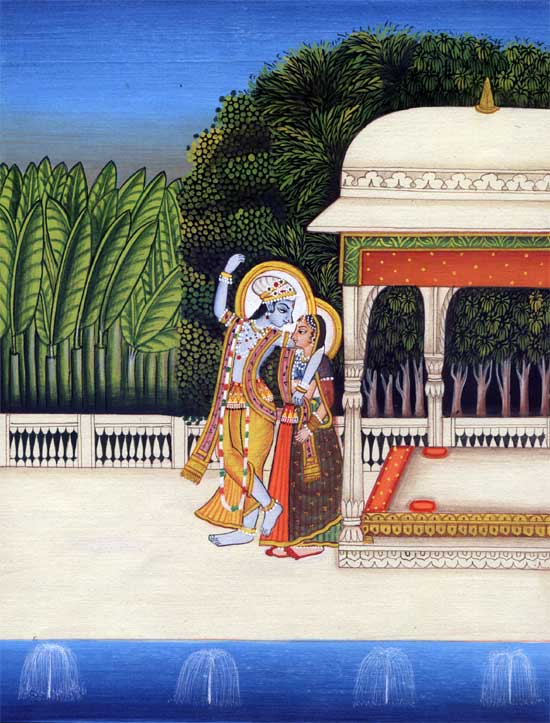 |
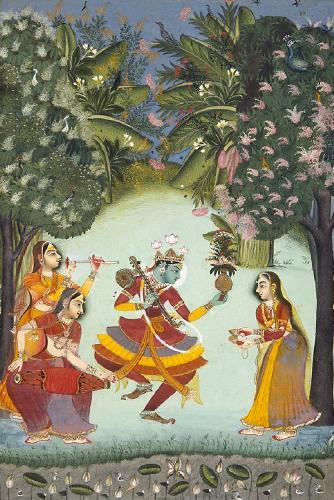 |
|
Paintings of
Rajasthan |
Miniature Painting |
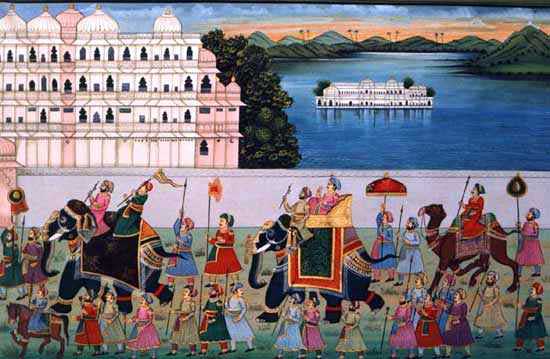 |
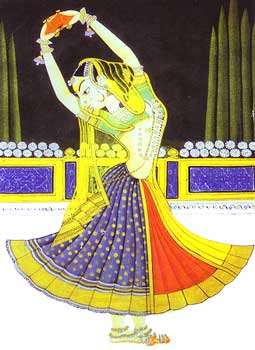 |
|
Paintings of Rajasthan
|
Miniature Painting
Kota |
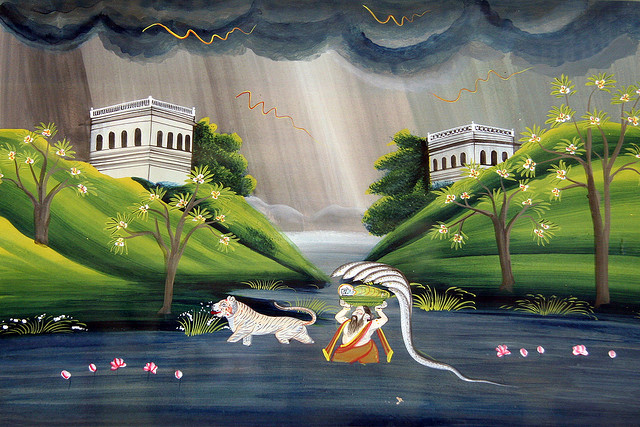 |
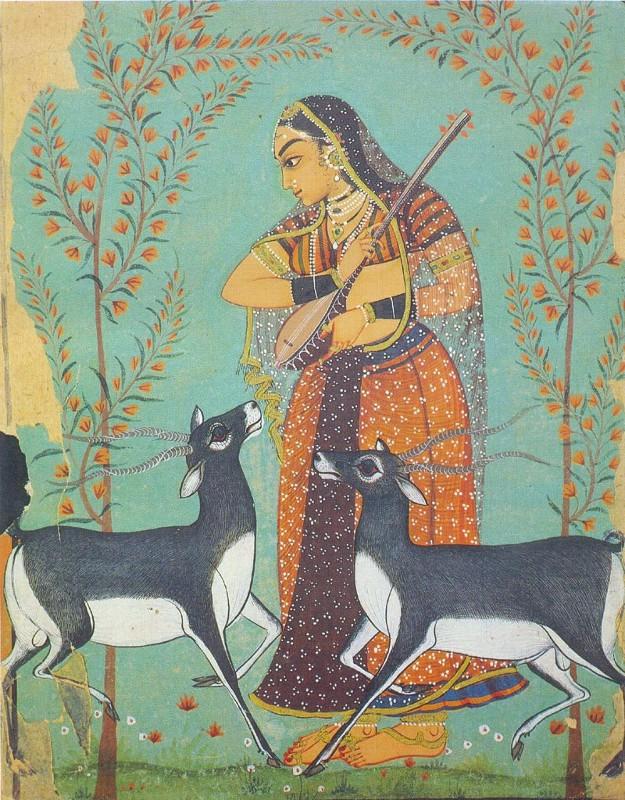 |
|
Paintings of Rajasthan
|
Paintings of
Rajasthan |
|
|
|
|
|
|